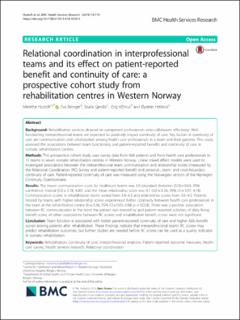| dc.contributor.author | Hustoft, Merethe | |
| dc.contributor.author | Biringer, Eva Aaker | |
| dc.contributor.author | Gjesdal, Sturla | |
| dc.contributor.author | Assmus, Jörg | |
| dc.contributor.author | Hetlevik, Øystein | |
| dc.date.accessioned | 2021-04-19T09:47:48Z | |
| dc.date.available | 2021-04-19T09:47:48Z | |
| dc.date.created | 2018-10-06T10:23:59Z | |
| dc.date.issued | 2018 | |
| dc.Published | BMC Health Services Research. 2018, 18:719 1-9. | |
| dc.identifier.issn | 1472-6963 | |
| dc.identifier.uri | https://hdl.handle.net/11250/2738311 | |
| dc.description.abstract | Background
Rehabilitation services depend on competent professionals who collaborate effectively. Well-functioning interprofessional teams are expected to positively impact continuity of care. Key factors in continuity of care are communication and collaboration among health care professionals in a team and their patients. This study assessed the associations between team functioning and patient-reported benefits and continuity of care in somatic rehabilitation centres.
Methods
This prospective cohort study uses survey data from 984 patients and from health care professionals in 15 teams in seven somatic rehabilitation centres in Western Norway. Linear mixed effect models were used to investigate associations between the interprofessional team communication and relationship scores (measured by the Relational Coordination [RC] Survey and patient-reported benefit and personal-, team- and cross-boundary continuity of care. Patient-reported continuity of care was measured using the Norwegian version of the Nijmegen Continuity Questionnaire.
Results
The mean communication score for healthcare teams was 3.9 (standard deviation [SD] = 0.63, 95% confidence interval [CI] = 3.78, 4.00), and the mean relationship score was 4.1 (SD = 0.56, 95% CI = 3.97, 4.18). Communication scores in rehabilitation teams varied from 3.4–4.3 and relationship scores from 3.6–4.5. Patients treated by teams with higher relationship scores experienced better continuity between health care professionals in the team at the rehabilitation centre (b = 0.36, 95% CI = 0.05, 0.68; p = 0.024). There was a positive association between RC communication in the team the patient was treated by and patient-reported activities of daily living benefit score; all other associations between RC scores and rehabilitation benefit scores were not significant.
Conclusion
Team function is associated with better patient-reported continuity of care and higher ADL-benefit scores among patients after rehabilitation. These findings indicate that interprofessional teams’ RC scores may predict rehabilitation outcomes, but further studies are needed before RC scores can be used as a quality indicator in somatic rehabilitation. | en_US |
| dc.language.iso | eng | en_US |
| dc.publisher | BMC | en_US |
| dc.rights | Navngivelse 4.0 Internasjonal | * |
| dc.rights.uri | http://creativecommons.org/licenses/by/4.0/deed.no | * |
| dc.title | Relational coordination in interprofessional teams and its effect on patient-reported benefit and continuity of care: a prospective cohort study from rehabilitation centres in Western Norway | en_US |
| dc.type | Journal article | en_US |
| dc.type | Peer reviewed | en_US |
| dc.description.version | publishedVersion | en_US |
| dc.rights.holder | Copyright The Author(s). 2018 | en_US |
| dc.source.articlenumber | 719 | en_US |
| cristin.ispublished | true | |
| cristin.fulltext | original | |
| cristin.qualitycode | 2 | |
| dc.identifier.doi | 10.1186/s12913-018-3536-5 | |
| dc.identifier.cristin | 1618324 | |
| dc.source.journal | BMC Health Services Research | en_US |
| dc.source.40 | 18:719 | |
| dc.identifier.citation | BMC Health Services Research. 2018, 18, 719. | en_US |
| dc.source.volume | 18 | en_US |

